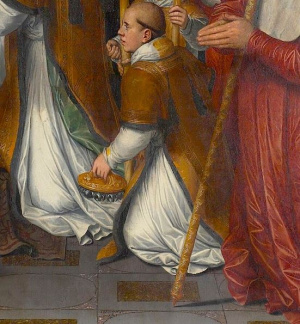Difference between revisions of "Altaarschel"
| (2 intermediate revisions by 2 users not shown) | |||
| Line 3: | Line 3: | ||
== Etymologie == | == Etymologie == | ||
| − | + | ||
| + | Schel: < oud Nederlands ''skella'' = kleine bel. | ||
== Definitie == | == Definitie == | ||
| Line 64: | Line 65: | ||
{| class="wikitable" | {| class="wikitable" | ||
!colspan="2"|Oude talen | !colspan="2"|Oude talen | ||
| − | |||
| − | |||
| − | |||
|- | |- | ||
!scope="row"| Oud- en Middelnederlands | !scope="row"| Oud- en Middelnederlands | ||
| − | |'' | + | |''skella'' |
|} | |} | ||
== BALaT == | == BALaT == | ||
| − | |||
[http://balat.kikirpa.be/results.php?typesearch=advanced&objectname=altaarschel&period_start=1400&period_end=1700&sort=unsorted De altaarschellen (1400-1700) in BALaT] | [http://balat.kikirpa.be/results.php?typesearch=advanced&objectname=altaarschel&period_start=1400&period_end=1700&sort=unsorted De altaarschellen (1400-1700) in BALaT] | ||
| Line 79: | Line 76: | ||
[http://balat.kikirpa.be/results_bib.php?typesearch=advanced&filter=all&IDs=altaarschel&sort=year&sort=yeardesc&limit=24 De altaarschellen in de bibliotheek van het KIK] | [http://balat.kikirpa.be/results_bib.php?typesearch=advanced&filter=all&IDs=altaarschel&sort=year&sort=yeardesc&limit=24 De altaarschellen in de bibliotheek van het KIK] | ||
| − | |||
| − | |||
| − | |||
| − | |||
== Bibliografische orientatie == | == Bibliografische orientatie == | ||
* Joseph Braun, [https://digi.ub.uni-heidelberg.de/diglit/braun1932 ''Das christliche Altargerät in seinem Sein und in seiner Entwicklung''], Munich, 1932, [https://digi.ub.uni-heidelberg.de/diglit/braun1932/0595 p. 573-577]. | * Joseph Braun, [https://digi.ub.uni-heidelberg.de/diglit/braun1932 ''Das christliche Altargerät in seinem Sein und in seiner Entwicklung''], Munich, 1932, [https://digi.ub.uni-heidelberg.de/diglit/braun1932/0595 p. 573-577]. | ||
| − | * ''Glossarium Artis'', Faszikel 2, ''Liturgische geräte, Kreuze une Reliquiare der Christlichen Kirchen - Objets liturgiques, croix et reliquaires des églises chrétiennes'', | + | * ''Glossarium Artis'', Faszikel 2, ''Liturgische geräte, Kreuze une Reliquiare der Christlichen Kirchen - Objets liturgiques, croix et reliquaires des églises chrétiennes'', Dokumentationsstelle Tûbingen, Tübingen-Strasbourg, 1972, p. 17. |
* Wendy Wauters, [https://www.academia.edu/41771810/The_Stirring_of_the_Religious_Soundscape_The_Auditory_Experience_in_the_Antwerp_Church_of_Our_Lady_c_1450_1566_and_an_Iconological_Analysis_of_the_Altar_Bell « The Stirring of the Religious Soundscape. The Auditory Experience in the Antwerp Church of Our Lady (c. 1450-1566) and an Iconological Analysis of the Altar Bell »], in ''Christian Discourses of the Holy and the Sacred from the 15th to the 17th Century'', eds. Teresa Hiergeist, Ismael del Olmo, Berlin, Peter Lang, 2020, p. 221-260. | * Wendy Wauters, [https://www.academia.edu/41771810/The_Stirring_of_the_Religious_Soundscape_The_Auditory_Experience_in_the_Antwerp_Church_of_Our_Lady_c_1450_1566_and_an_Iconological_Analysis_of_the_Altar_Bell « The Stirring of the Religious Soundscape. The Auditory Experience in the Antwerp Church of Our Lady (c. 1450-1566) and an Iconological Analysis of the Altar Bell »], in ''Christian Discourses of the Holy and the Sacred from the 15th to the 17th Century'', eds. Teresa Hiergeist, Ismael del Olmo, Berlin, Peter Lang, 2020, p. 221-260. | ||
Latest revision as of 17:24, 29 November 2021
Contents
Etymologie
Schel: < oud Nederlands skella = kleine bel.
Definitie
De altaarschel heeft dezelfde functie als een altaarbel maar heeft meer belletjes.
Hierarchie
Oorsprong en ontwikkeling
Klokjes en bellen verschijnen in de kerkinventarissen ten minste vanaf de 10de eeuw. Het luiden van de altaarbel of de altaarschellen tijdens de Consecratie is als gebruik gedocumenteerd sinds de 13de eeuw. Vanaf de 15de eeuw luidt men ze eveneens tijdens het Sanctus. Het gebruik van de altaarschellen is van recentere datum dan dat van de altaarbel. Het raakt pas helemaal op het einde van de 16de eeuw in zwang.
Typologie
Altaarschellen vormen een geheel van meerdere klokjes, soms bijeengebracht onder een veelal versierde of opengewerkte koepel, waaraan een handvat is bevestigd. In andere gevallen zijn de bellen eenvoudigweg verbonden met armen.
Normatieve teksten
De normatieve teksten maken geen onderscheid tussen altaarbellen en altaarschellen. Het gebruik van bellen staat niet in de eerste uitgave van de Missale Romanum' van 1570, maar pas vanaf 1604.
- Missale Romanum, Rubricae generales Missalis, titel XX - De Præparatione Altaris, et Ornamentorum ejus (herziene en vermeerderde uitgave van 1604 en later):
- Missale Romanum, Ritus celebrandi Missam, VII - De Offertorio et aliis usque ad Canonem (herziene en vermeerderde uitgave van 1604 en later):
- Missale Romanum, Ritus celebrandi Missam, VIII - De Canone Missae usque ad Consecrationem (herziene en vermeerderde uitgave van 1604 en later):
Andere benamingen
altaarcarillon
| Autres langues | |
|---|---|
| FR | carillon d'autel |
| EN | altar bell X sounds, X cup church bell |
| DE | Zimbel, Altarschelle |
| IT | campanello d'altare multiplo, campanello liturgico a X suoni |
| ES | carrillón para iglesia |
| Oude talen | |
|---|---|
| Oud- en Middelnederlands | skella |
BALaT
De altaarschellen (1400-1700) in BALaT
Afbeelding van altaarschellen (1400-1700) in BALaT
De altaarschellen in de bibliotheek van het KIK
Bibliografische orientatie
- Joseph Braun, Das christliche Altargerät in seinem Sein und in seiner Entwicklung, Munich, 1932, p. 573-577.
- Glossarium Artis, Faszikel 2, Liturgische geräte, Kreuze une Reliquiare der Christlichen Kirchen - Objets liturgiques, croix et reliquaires des églises chrétiennes, Dokumentationsstelle Tûbingen, Tübingen-Strasbourg, 1972, p. 17.
- Wendy Wauters, « The Stirring of the Religious Soundscape. The Auditory Experience in the Antwerp Church of Our Lady (c. 1450-1566) and an Iconological Analysis of the Altar Bell », in Christian Discourses of the Holy and the Sacred from the 15th to the 17th Century, eds. Teresa Hiergeist, Ismael del Olmo, Berlin, Peter Lang, 2020, p. 221-260.

